Mitigation of Fracturing Fluid Leak-Off and Subsequent Formation Damage Caused by Coal Fine Invasion in Fractures: An Experimental Study
Abstract
:1. Introduction
2. Experimental Methodology
2.1. Sample Preparation
2.2. Experimental Apparatus
2.3. Experimental Conditions and Procedures
- (1)
- Preparation: After vacuuming and saturating the prepared coal sample with a 2% KCl solution for 48 h, load it into the core holder. Start pump B and set the confining pressure to 3 MPa. Load the prepared coal fine suspension into the intermediate container and continue stirring to ensure uniform dispersion in the 2% KCl solution.
- (2)
- Initial permeability measurement: Open valve B and start pump A. Set the pump A liquid injection rate to 1 mL/min of 2% KCl solution into the core holder. Monitor the pressure difference across the core holder in real time. Once the pressure difference stabilizes, measure the initial permeability of the coal sample. The permeability calculation follows Darcy’s law:where K is the permeability of the coal sample, m2; p1 and pa are the inlet and outlet pressures of the core holder, Pa; q is the liquid flow rate, m3/s; μ is the liquid viscosity, Pa·s; A is the cross-sectional area of the coal sample, m2; and L is the length of the coal sample, m.
- (3)
- Temporary plugging experiment: Close valve B and pump A, then sequentially open valve A and the gas cylinder. Set the output pressure of the gas cylinder to 2 MPa and inject the liquid from the intermediate container into the core holder at constant pressure. Continuously monitor the leak-off of the fracturing fluid and calculate the temporary plugging rate of coal fines in the fracturing fluid:where τp is the temporary plugging rate, %; K0 is the initial permeability of the coal sample, m2; and Kp is the temporary plugging permeability of the coal sample, m2.
- (4)
- Unplugging experiment: Close the gas cylinder and valve A in sequence, then open valve B and start pump A. Inject 2% KCl solution into the core holder at 1 mL/min. Monitor the pressure difference across the core holder in real time and collect the output liquid during the unplugging process. Calculate the damage rate of coal fines to the permeability of the coal sample after unplugging:where ηd is the permeability damage rate due to coal fines, %; and Kd is the permeability of the coal sample after the unplugging pressure stabilizes, m2.
- (5)
- Post-experimental processing: Release the pressure from the experimental system, remove the coal sample, clean the coal sample and equipment, and restore the initial operational settings of the apparatus. Varying the coal fine parameters for Tests No. 1–7, repeat steps 1–5. Analyze the impact of coal fines of different concentrations and particle sizes in the fracturing fluid on the temporary plugging rate and the permeability damage rate.
3. Results and Discussion
3.1. Characteristics of Temporary Plugging of Coal Fines
3.2. Strength of Plugging and Mechanisms of Unplugging
3.3. Formation Damage Caused by Temporary Plugging with Coal Fines
4. Conclusions
- (1)
- Coal fines act as a natural “temporary plugging agent” to reduce fracturing fluid leak-off, and temporary plugging rates increase with higher concentrations and decrease with larger particle sizes.
- (2)
- The high temporary plugging effect of coal fines occurs through the combination of internal and external filter cakes. Increased coal fine concentration enhances plugging strength, while larger particle sizes reduce it. The permeability damage rate caused by temporary plugging coal fines in fractures initially increases and then decreases with increasing concentration and particle size. However, relatively lower damage rates occur under the conditions of smaller particle sizes and higher concentrations.
- (3)
- In balancing the temporary plugging rate and damage rate of coal fines on coal seam fractures, it is beneficial to maintain a lower concentration of coal fines in the fracturing fluid while ensuring a high temporary plugging rate. This approach helps mitigate the damage to the CBM production channel system during extraction. Simultaneously, during the hydraulic fracturing stage, temporary plugging by coal fines can compensate for fracturing fluid leak-off, thereby enhancing the effectiveness of reservoir fracturing and production enhancement.
Author Contributions
Funding
Data Availability Statement
Conflicts of Interest
References
- Xu, F.Y.; Hou, W.; Xiong, X.Y.; Xu, B.R.; Wu, P.; Wang, H.Y.; Feng, K.; Yun, J.; Li, S.G.; Zhang, L.; et al. The status and development strategy of coalbed methane industry in China. Petrol. Explor. Dev. 2023, 50, 765–783. [Google Scholar] [CrossRef]
- Liang, W.G.; Yan, J.W.; Zhang, B.N.; Hou, D.S. Review on coal bed methane recovery theory and technology: Recent progress and perspectives. Energy Fuels 2021, 35, 4633–4643. [Google Scholar] [CrossRef]
- Altowilib, A.; AlSaihati, A.; Alhamood, H.; Alafnan, S.; Alarifi, S. Reserves estimation for coalbed methane reservoirs: A review. Sustainability 2020, 12, 10621. [Google Scholar] [CrossRef]
- Wang, X.L.; Pan, J.N.; Wang, K.; Mou, P.W.; Li, J.X. Fracture variation in high-rank coal induced by hydraulic fracturing using X-ray computer tomography and digital volume correlation. Int. J. Coal Geol. 2022, 252, 103942. [Google Scholar] [CrossRef]
- Liu, J.S.; Chen, Z.W.; Elsworth, D.; Qu, H.Y.; Chen, D. Interactions of multiple processes during CBM extraction: A critical review. Int. J. Coal Geol. 2011, 87, 175–189. [Google Scholar] [CrossRef]
- Zhu, Y.R.; Shi, Z.; Zuo, S.J.; Qu, Q.D.; Yan, X.L.; Kuznetsov, D.; Nehring, M.; Chen, Z.W. Dewatering optimization of coal seam gas production wells: A review and future perspectives. Energy Fuels 2022, 36, 9785–9820. [Google Scholar] [CrossRef]
- Odumabo, S.M.; Karpyn, Z.T.; Ayala, H.L.F. Investigation of gas flow hindrance due to fracturing fluid leakoff in low permeability sandstones. J. Nat. Gas Sci. Eng. 2014, 17, 1–12. [Google Scholar] [CrossRef]
- Wang, D.Y.; Wang, Z.M.; Cai, X.L. Experimental study on coal fines migration and effects on conductivity of hydraulic fracture during entire coalbed methane production period. Geoenergy Sci. Eng. 2023, 223, 211555. [Google Scholar] [CrossRef]
- Yarushina, V.M.; Bercovici, D.; Oristaglio, M.L. Rock deformation models and fluid leak-off in hydraulic fracturing. Geophys. J. Int. 2013, 194, 1514–1526. [Google Scholar] [CrossRef]
- Awan, F.U.R.; Keshavarz, A.; Akhondzadeh, H.; Al-Anssari, S.; Al-Yaseri, A.; Nosrati, A.; Ali, M.; Iglauer, S. Stable dispersion of coal fines during hydraulic fracturing flowback in coal seam gas reservoirs-an experimental study. Energy Fuels 2020, 34, 5566–5577. [Google Scholar] [CrossRef]
- Guo, Z.H.; Kang, N.; Le-Hussain, F. An NMR-assisted laboratory investigation of coal fines migration in fracture proppants during single-phase water production. Fuel 2023, 343, 127926. [Google Scholar] [CrossRef]
- Zou, Y.S.; Zhang, S.C.; Zhang, J. Experimental method to simulate coal fines migration and coal fines aggregation prevention in the hydraulic fracture. Transp. Porous Med. 2014, 101, 17–34. [Google Scholar] [CrossRef]
- Zhang, C.; Liu, C.X.; Xu, W.Y.; Zhao, Y.X.; Song, Z.Y.; Zhang, L. Zonal seepage in coal seams generated by hydraulic fracturing under gas pressure attenuation: Characteristics and affecting factors. Nat. Resour. Res. 2024, 33, 1173–1191. [Google Scholar] [CrossRef]
- Chen, B.; Barboza, B.R.; Sun, Y.N.; Bai, J.; Thomas, H.R.; Dutko, M.; Cottrell, M.; Li, C.F. A review of hydraulic fracturing simulation. Arch. Comput. Meth. Eng. 2022, 29, 1–58. [Google Scholar] [CrossRef]
- Li, J.; Kuang, S.B.; Qi, Z.; Liu, P.L.; Yu, A.B. Experimental investigation of the leak-off effect on proppant transportation and distribution in a vertical fracture. J. Nat. Gas. Sci. Eng. 2022, 97, 104358. [Google Scholar] [CrossRef]
- Wei, Y.C.; Li, C.; Cao, D.Y.; Wang, A.M.; Zhang, A.X.; Yao, Z. The effects of particle size and inorganic mineral content on fines migration in fracturing proppant during coalbed methane production. J. Petrol. Sci. Eng. 2019, 182, 106355. [Google Scholar] [CrossRef]
- Tao, S.; Tang, D.Z.; Xu, H.; Li, S. The influence of flow velocity on coal fines output and coal permeability in the Fukang Block, southern Junggar Basin, China. Sci. Rep. 2017, 7, 14124. [Google Scholar] [CrossRef] [PubMed]
- Tao, S.; Tang, D.; Xu, H.; Li, S.; Geng, Y.G.; Zhao, J.L.; Wu, S.; Meng, Q.; Kou, X.; Yang, S.Y.; et al. Fluid velocity sensitivity of coal reservoir and its effect on coalbed methane well productivity: A case of Baode Block, northeastern Ordos Basin, China. J. Petrol. Sci. Eng. 2017, 152, 229–237. [Google Scholar] [CrossRef]
- Huang, F.S.; Kang, Y.L.; You, Z.J.; You, L.J.; Xu, C.Y. Critical conditions for massive fines detachment induced by single-phase flow in coalbed methane reservoirs: Modeling and experiments. Energy Fuels 2017, 31, 6782–6793. [Google Scholar] [CrossRef]
- Bai, T.H.; Chen, Z.W.; Aminossadati, S.M.; Rufford, T.E.; Li, L. Experimental investigation on the impact of coal fines generation and migration on coal permeability. J. Petrol. Sci. Eng. 2017, 159, 257–266. [Google Scholar] [CrossRef]
- Wei, Y.C.; Zhang, Q.; Liu, Z.L.; Li, B.; Xie, T.C.; Ren, J.W.; Wang, A.M.; Cao, D.Y. Visual physical simulation experiment of coal fines migration and blockage removal in fractures. J. China Coal Soc. 2024, 49, 1488–1500. [Google Scholar]
- Cao, D.Y.; Yao, Z.; Li, X.M.; Wei, Y.C.; Hu, A.M.; Song, B. Rules of coal powder output under physical simulation experiments of single-phase water flow displacement. J. China Coal Soc. 2013, 38, 624–628. [Google Scholar]
- Han, W.L.; Wang, Y.B.; Fan, J.J.; Li, Y.; Wu, X.; Yu, Y. An experimental study on coal fines migration during single phase water flow. Geofluids 2020, 2020, 3974790. [Google Scholar] [CrossRef]
- Huang, F.S.; Sang, S.X.; Liu, S.Q.; Chen, Q.; Zhou, X.Z.; Wang, M. Impact of salinity of fracturing fluid on the migration of coal fines in propped fractures and cleats. J. China Coal Soc. 2023, 48, 1622–1633. [Google Scholar]
- Lu, Y.; Kang, Y.L.; Bu, C.Z.; Li, Y.; Lin, C.; You, Z.J. Permeability enhancement and coal fines removal through oxidation treatment in coalbed methane reservoirs. Fuel 2024, 358, 130320. [Google Scholar] [CrossRef]
- Han, W.L.; Wang, Y.B.; Li, Y.; Ni, X.M.; Wu, X.; Yang, J.H.; Zhao, S.H. Coal fines migration, deposition, and output simulation during drainage stage in coalbed methane production. Energy Fuels 2021, 35, 4901–4913. [Google Scholar] [CrossRef]
- Zhao, Z.; Ni, X.M.; Liu, Z.D.; Wu, X. Attenuation characteristics of coal fissure induced by gas-water twophase drive. J. China Coal Soc. 2020, 45, 3853–3863. [Google Scholar]
- Mu, T.; Ma, D.G.; Chen, Y.; Gao, Z.; Zhang, H.; Teng, J.X.; Yang, F.; Shao, K.; Zhang, L. Start-migration law of coal powder with different particle sizes undermulti-phase flow conditions in coalbed methane wells. Coal Sci. Technol. 2020, 48, 188–196. [Google Scholar]
- Han, W.L.; Li, Y.; Chen, X.S.; Zhuo, Q.M.; Wang, Y.B. Mechanism of coal fine-bubble coupling in the unsaturated flow stage of coalbed methane drainage. Coal Geol. Explor. 2023, 51, 46–53. [Google Scholar]
- Huang, F.S.; Kang, Y.L.; You, L.J.; Li, X.C.; You, Z.J. Massive fines detachment induced by moving gas-water interfaces during early stage two-phase flow in coalbed methane reservoirs. Fuel 2018, 222, 193–206. [Google Scholar] [CrossRef]
- Zhu, S.Y.; Peng, X.L.; Du, Z.M.; Wang, C.W.; Deng, P.; Mo, F.; Lei, Y.; Wang, M.W. Modeling of coal fine migration during CBM production in high-rank coal. Transp. Porous Med. 2017, 118, 65–83. [Google Scholar] [CrossRef]
- Han, G.Q.; Ling, K.G.; Wu, H.X.; Gao, F.; Zhu, F.; Zhang, M. An experimental study of coal-fines migration in Coalbed-methane production wells. J. Nat. Gas Sci. Eng. 2015, 26, 1542–1548. [Google Scholar] [CrossRef]
- Mehrdad, V.F.; Sajjad, F.; Sevda, N.; Saeid, J. Mechanistic study of fines migration in porous media using lattice boltzmann method coupled with rigid body physics engine. J. Energy Resour. Technol. 2019, 141, 123001. [Google Scholar]
- Huang, F.S.; Dong, C.Y.; Shang, X.S.; You, Z.J. Effects of proppant wettability and size on transport and retention of coal fines in saturated proppant packs: Experimental and theoretical studies. Energy Fuels 2021, 35, 11976–11991. [Google Scholar] [CrossRef]
- Zhang, X.T.; Hu, S.Y.; Hao, Y.X.; Feng, G.R.; Li, S.Y.; Chen, Z.Y. Effect of coal fine retention on the permeability of hydraulic propped fracture. Rock Mech. Rock Eng. 2022, 55, 6001–6014. [Google Scholar] [CrossRef]
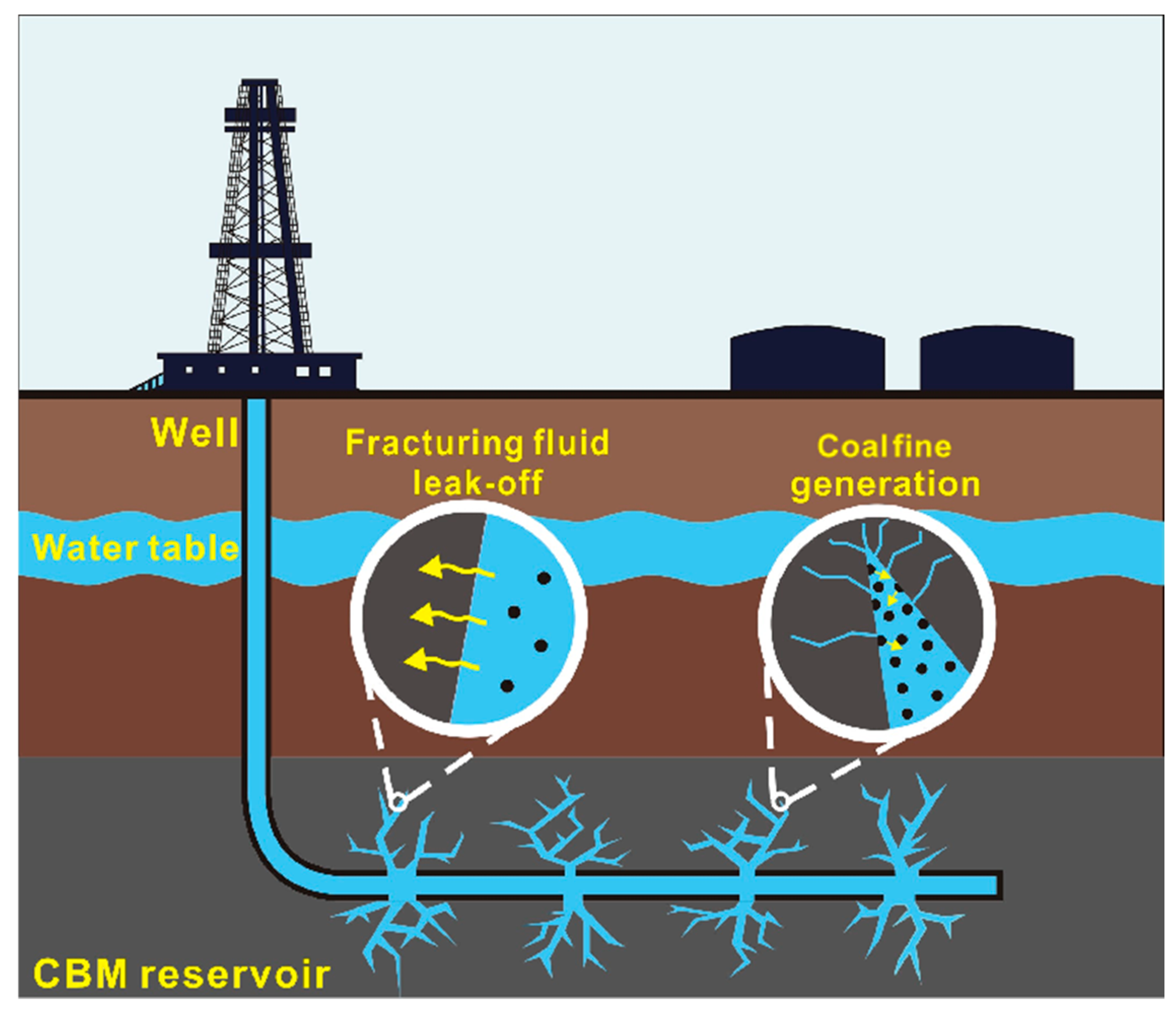
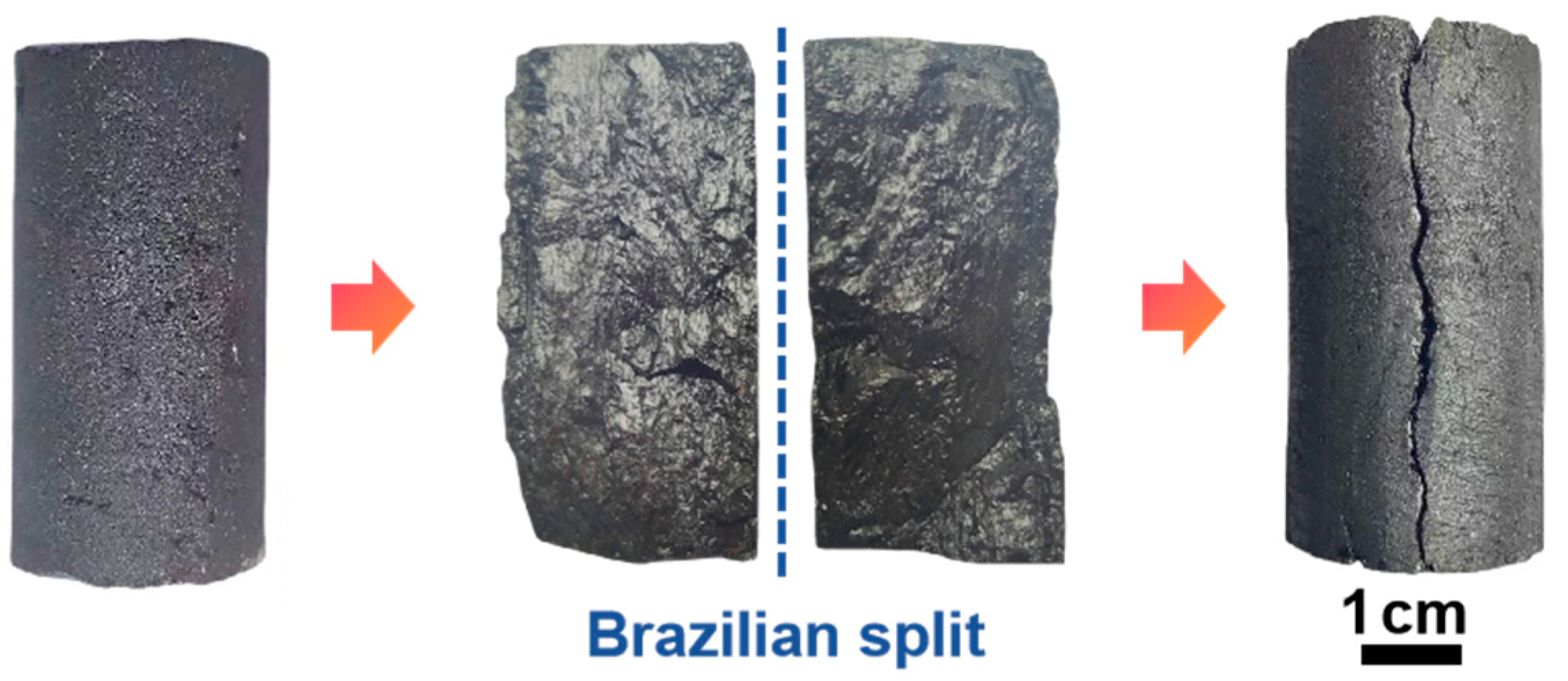

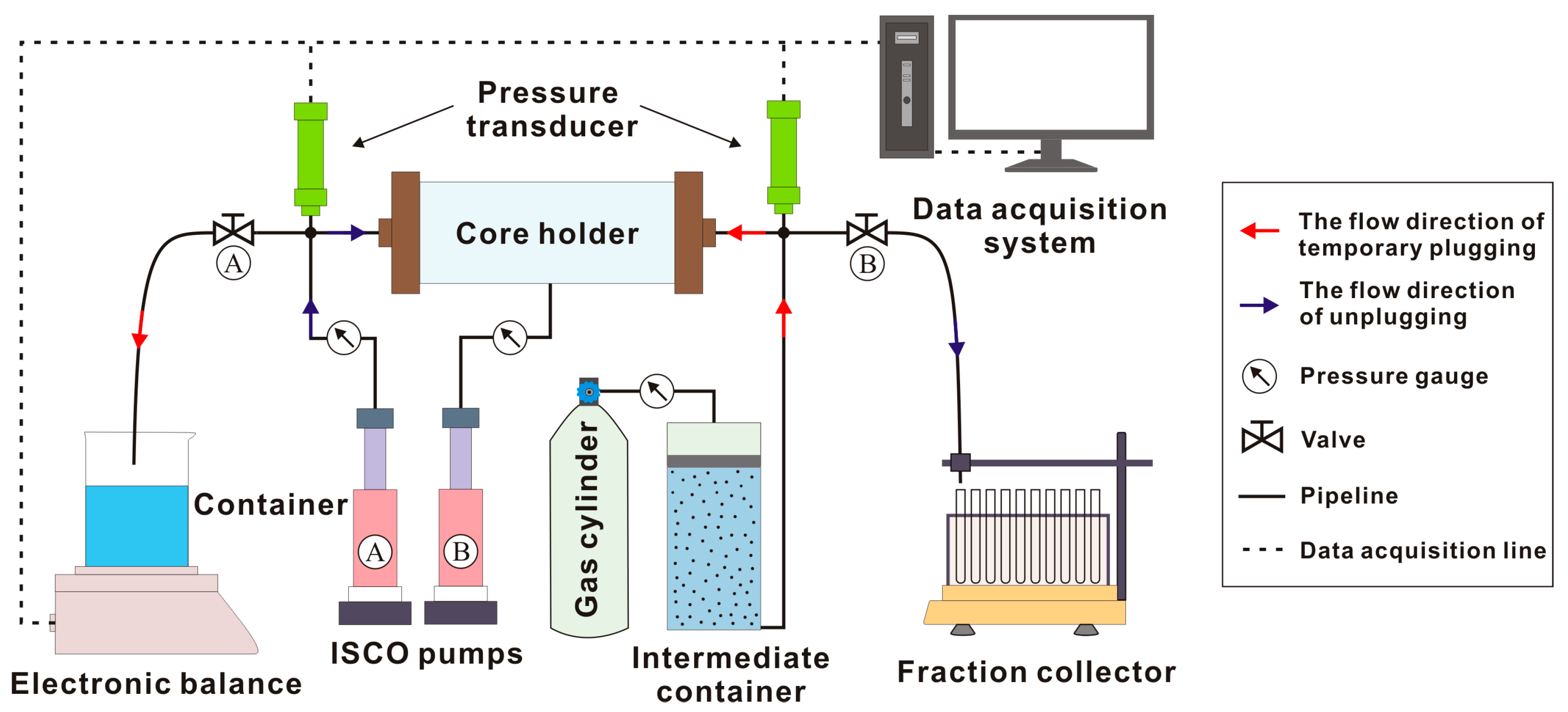
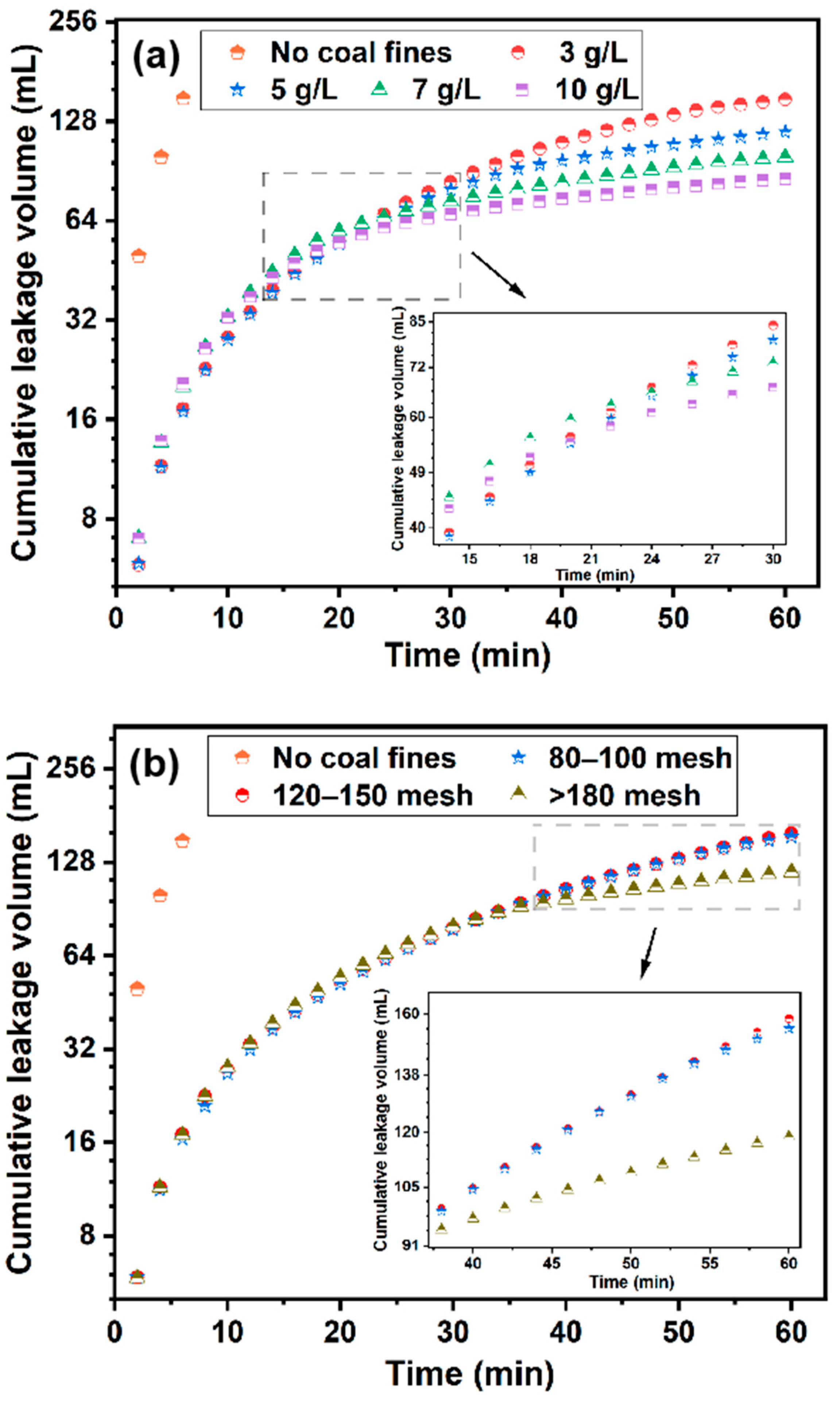


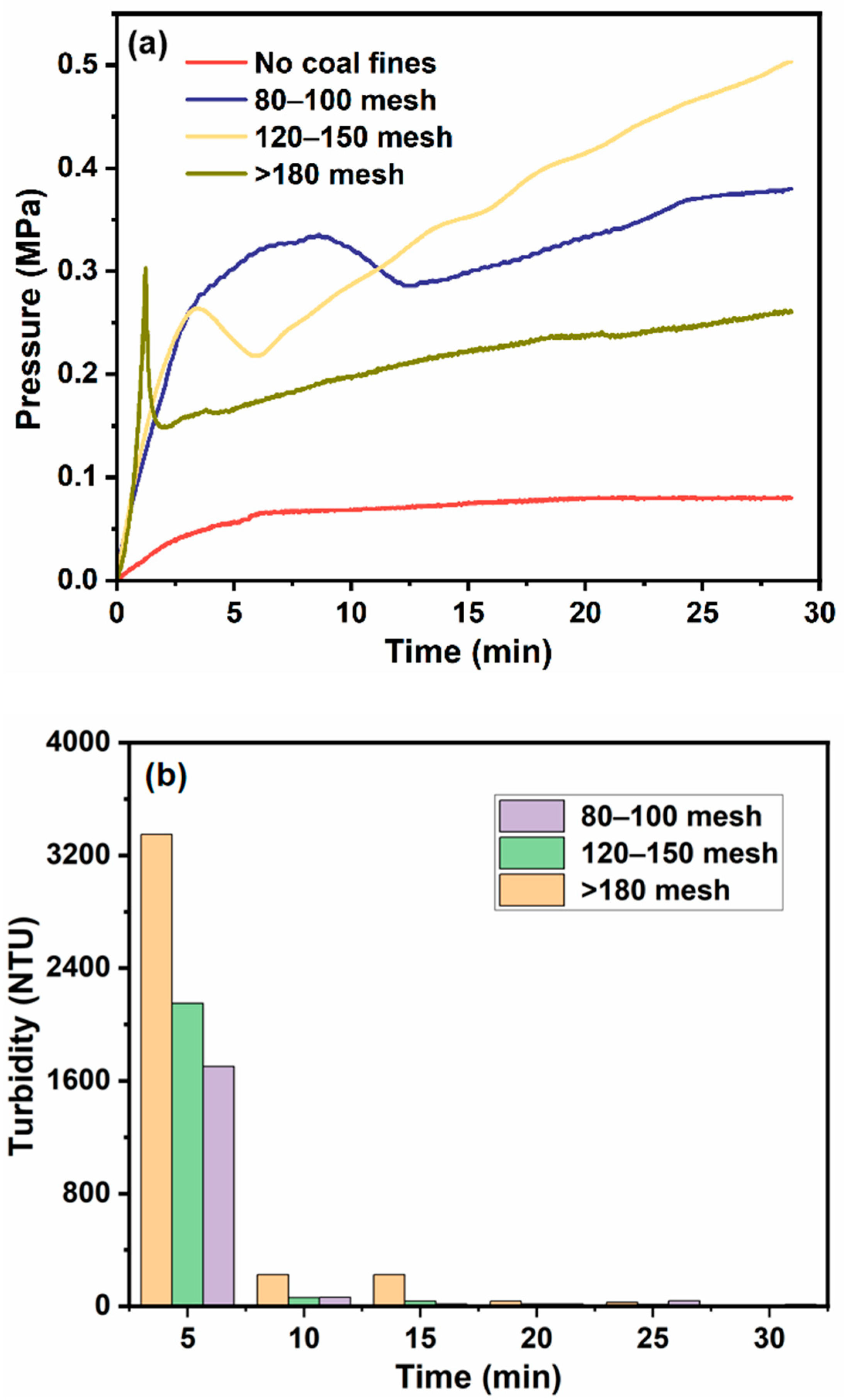
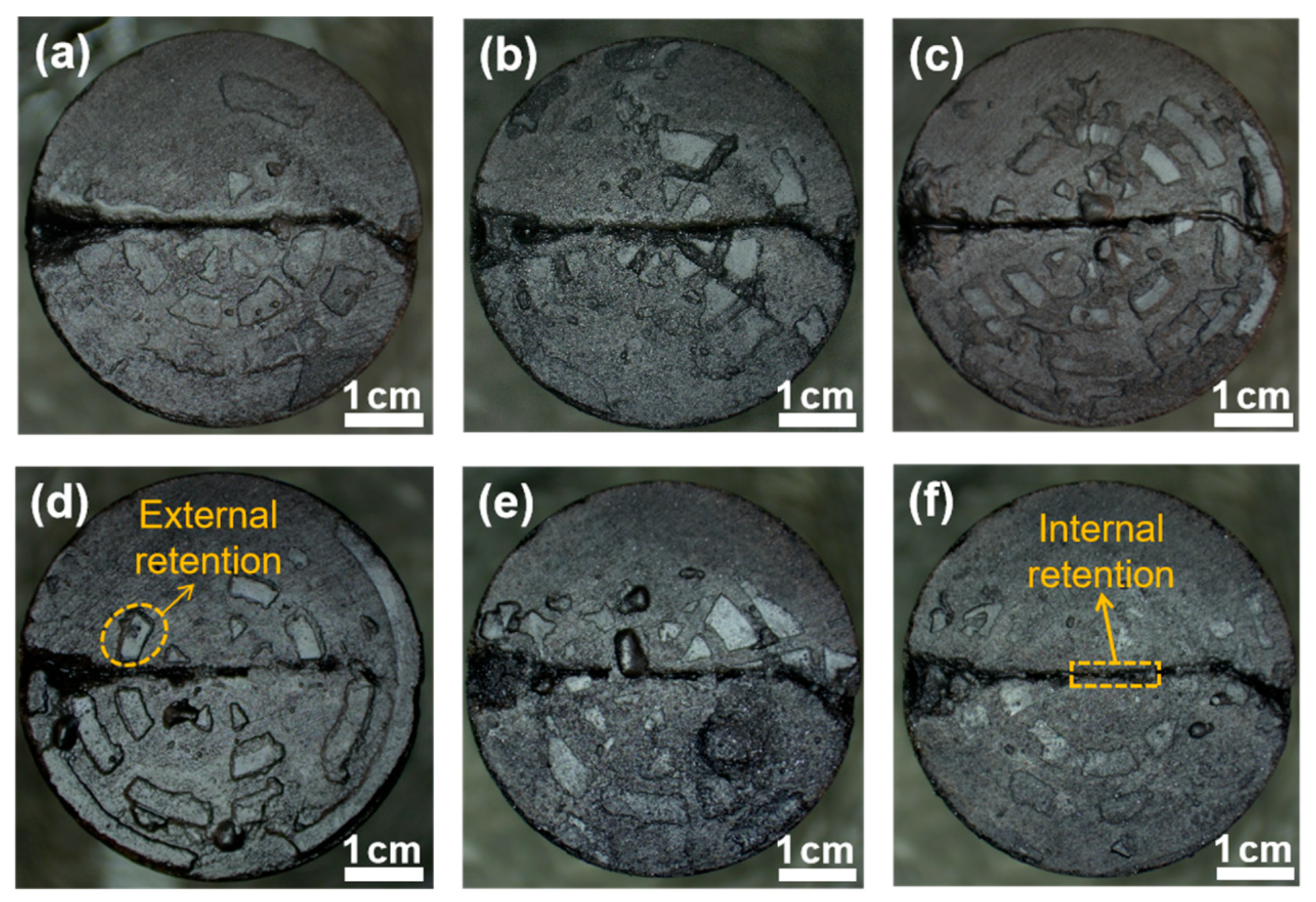

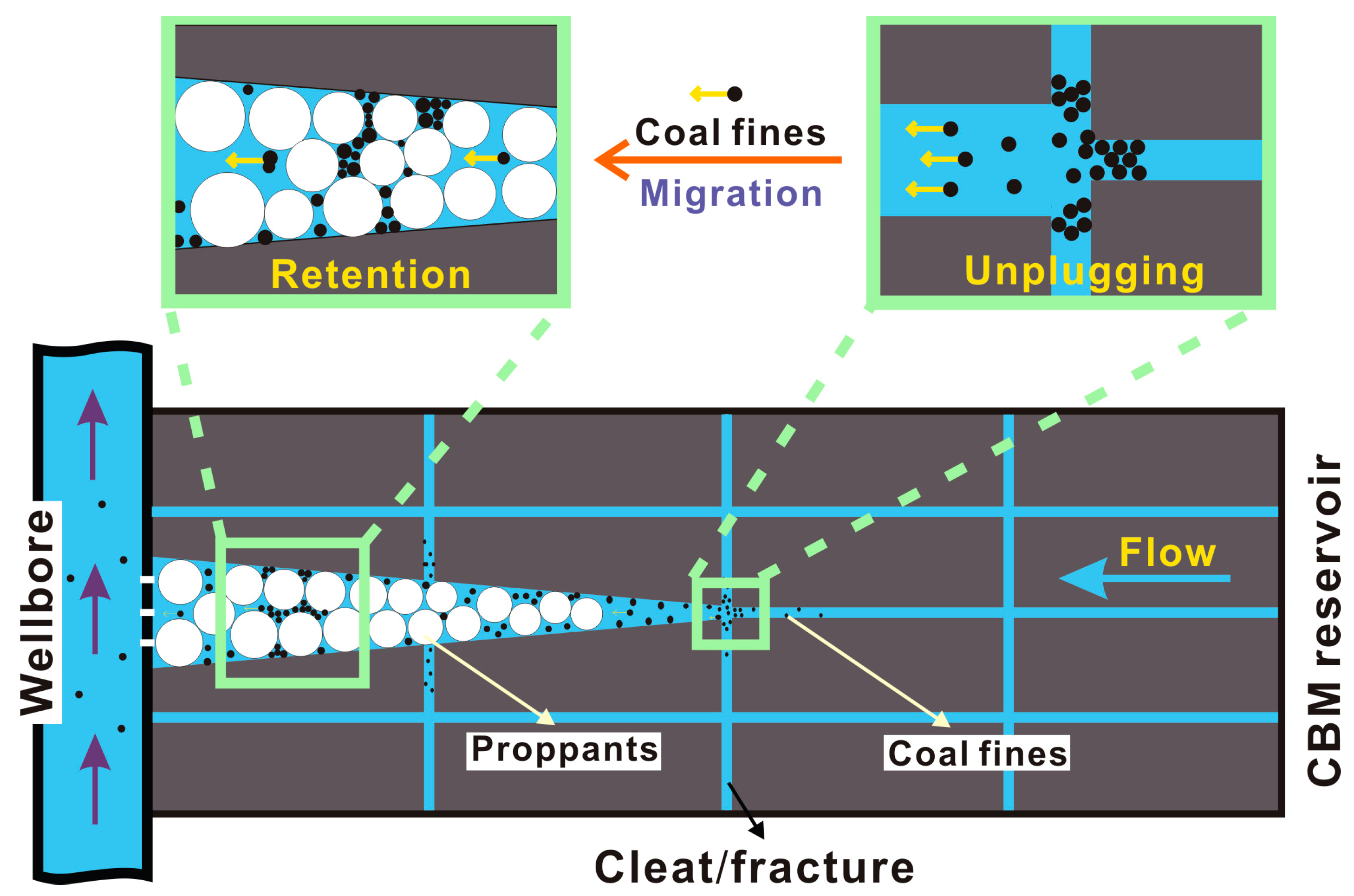
| Test Name | Test Content | Test Result | |
|---|---|---|---|
| Analysis of maceral composition in coal sample | Demineralized bases (%) | Vitrinite | 78.75 |
| Inertinite | 21.25 | ||
| Exinite | - | ||
| Mineral containing bases (%) | Total organic content | 29.41 | |
| Clay | 5.80 | ||
| Carbonate | 1.79 | ||
| Average random reflectance (%) | 1.78 | ||
| Standard deviation (%) | 0.068 | ||
| Quantitative analysis of whole-rock X-ray diffraction | Calcite (%) | 30.5 | |
| Dolomite (%) | 9.3 | ||
| TCCM (%) | 60.2 | ||
| Industrial and elemental analysis of coal samples | Cinder feature (1–8) | 4 | |
| Proximate analysis (%) | Mad | 1.18 | |
| Aad | 12.58 | ||
| Vad | 14.80 | ||
| FCad | 74.48 | ||
| Ultimate analysis (%) | St,d | 0.30 | |
| Cdaf | 90.13 | ||
| Hdaf | 4.09 | ||
| Odaf | 3.96 | ||
| Ndaf | 1.48 | ||
| Test No. | Coal Fine Parameters | Temporary Plugging | Unplugging | |
|---|---|---|---|---|
| Concentration (g/L) | Particle Size (Mesh) | |||
| 1 | No coal fines | No coal fines | Confining pressure: 3 MPa Plugging pressure: 2 MPa Plugging time: 60 min | Confining pressure: 3 MPa Unplugging velocity: 1 mL/min Unplugging time: 30 min |
| 2 | 3 | >180 | ||
| 3 | 5 | >180 | ||
| 4 | 7 | >180 | ||
| 5 | 10 | >180 | ||
| 6 | 5 | 120–150 | ||
| 7 | 5 | 80–100 | ||
| Test No. | Coal Fine Parameters | Permeability (mD) | |
|---|---|---|---|
| Concentration (g/L) | Particle Size (Mesh) | ||
| 1 | No coal fines | No coal fines | 62.64 |
| 2 | 3 | >180 | 3.21 |
| 3 | 5 | >180 | 2.38 |
| 4 | 7 | >180 | 1.34 |
| 5 | 10 | >180 | 0.89 |
| 6 | 5 | 120–150 | 4.87 |
| 7 | 5 | 80–100 | 6.44 |
| Test No. | Coal Fine Parameters | Permeability (mD) | |
|---|---|---|---|
| Concentration (g/L) | Particle Size (Mesh) | ||
| 1 | No coal fines | No coal fines | 62.64 |
| 2 | 3 | >180 | 32.12 |
| 3 | 5 | >180 | 19.27 |
| 4 | 7 | >180 | 46.84 |
| 5 | 10 | >180 | 55.07 |
| 6 | 5 | 120–150 | 9.96 |
| 7 | 5 | 80–100 | 13.19 |
Disclaimer/Publisher’s Note: The statements, opinions and data contained in all publications are solely those of the individual author(s) and contributor(s) and not of MDPI and/or the editor(s). MDPI and/or the editor(s) disclaim responsibility for any injury to people or property resulting from any ideas, methods, instructions or products referred to in the content. |
© 2024 by the authors. Licensee MDPI, Basel, Switzerland. This article is an open access article distributed under the terms and conditions of the Creative Commons Attribution (CC BY) license (https://creativecommons.org/licenses/by/4.0/).
Share and Cite
Wang, F.; Huang, F.; Guan, Y.; Xu, Z. Mitigation of Fracturing Fluid Leak-Off and Subsequent Formation Damage Caused by Coal Fine Invasion in Fractures: An Experimental Study. Processes 2024, 12, 1711. https://doi.org/10.3390/pr12081711
Wang F, Huang F, Guan Y, Xu Z. Mitigation of Fracturing Fluid Leak-Off and Subsequent Formation Damage Caused by Coal Fine Invasion in Fractures: An Experimental Study. Processes. 2024; 12(8):1711. https://doi.org/10.3390/pr12081711
Chicago/Turabian StyleWang, Fengbin, Fansheng Huang, Yiting Guan, and Zihan Xu. 2024. "Mitigation of Fracturing Fluid Leak-Off and Subsequent Formation Damage Caused by Coal Fine Invasion in Fractures: An Experimental Study" Processes 12, no. 8: 1711. https://doi.org/10.3390/pr12081711




